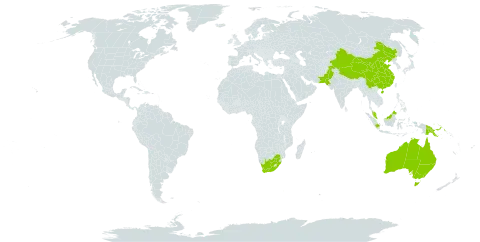Stems medium, yellowish. Flowers often somewhat glandular, 2-3 mm long, subsessile, in loose to dense subglobose clusters. Calyx ± as long as corolla tube; lobes broad, ovate to suborbicular, apex rounded. Corolla campanulate; lobes shorter than or as long as tube, erect to somewhat spreading, broad, apex rounded. Stamens shorter than corolla lobes; filaments usually stout, ± subulate and often shorter than (sometimes ± as long as) broadly elliptic to suborbicular anthers. Scales oblong, shorter than tube, bifid or bilobed to entire, variously fimbriate. Ovary globose; styles shorter than ovary, intrastylar aperture 1.0-1.5 mm long. Capsule globose or somewhat obovoid, not dehiscent by circumscission, drying reddish brown. Seeds ellipsoid to ovoid, 1.25-2.0 mm long.
Stems golden, thin, ca. 1 mm in diam. Inflorescences lateral, compact cymose glomerules, few to many flowered, subsessile; bracts scaly. Pedicel 1-2.5 mm. Calyx cupular, ca. as long as corolla tube; sepals 3-5, oblong or circular, often unequal, 0.8-1.8 mm, apex rotund. Corolla white or creamy white, cupular, ca. 2 mm; lobes persistent, erect, ovate or oblong. Stamens inserted at sinus, shorter than lobes; scales shorter than tube, deeply 2-cleft, fimbrillate. Ovary depressed globose. Styles 2, equal or unequal in length; stigmas globose. Capsule enclosed by persistent corolla, depressed-globose, 3-4 mm in diam., irregularly opening, not circumscissile. Seeds 4, brownish, ovoid, ca. 1.5 mm, scabrous.
Stems thin, filiform, greenish yellow to orange. Flowers 2-2.5 mm long, in compact clusters. Calyx about as long as corolla-tube; lobes ovate to orbicular, obtuse. Corolla white, greenish white or creamy white; lobes slightly shorter than or as long as the tube, broadly ovate or narrower, obtuse or subobtuse, erect or spreading. Stamens slightly shorter than the corolla-lobes; filaments as long as or longer than the anthers. Corolla-scales short, deeply bifid with few long fimbriae. Styles shorter than the depressed-globose ovary. Capsule depressed-globose or obpyriform, 3-4 mm diam., with large interstylar opening, not circumscissile. Seeds 4-3, oval, 1.5 mm long, brownish.
Scales shorter than the tube, reaching nearly to the base of the filaments, much fringed apically, not bifid or variously bifid sometimes consisting of one fringed lobe on either side of the area of the corolla tube below the filaments.
Twining parasite. Scales in corolla tube bifid at apex or entire. Corolla lobes obtuse, usually shorter than tube. Styles 2, free to base; stigmas globose. Flowers 5-mer-ous, subsessile, in globose clusters. Flowers cream or yellow.
Stamens shorter than the corolla lobes; filaments usually very short and stout, more or less subulate; anthers broadly elliptic to subcircular.
Corolla campanulate; lobes rounded, obtuse or somewhat triangular but blunt, shorter than or as long as the tube, erect to somewhat spreading.
A herb. It is a slender thread like creeper. It grows attached to other plants. The flowers are about 2 mm across in compact heads.
Capsule globose or somewhat obpyriform, not splitting at base; intrastylar opening 1–1·5 mm. long, often almost circular.
Flowers 2–3 mm. long and broad, accrescent in fruit, often somewhat glandular, subsessile, often obpyriform in fruit.
Leafless parasitic twiner with very slender tangled stems bright yellow or reddish-orange in colour
Calyx about as long as the corolla tube; lobes broad, ovate-circular, obtuse, not overlapping.
Ovary globose; styles stout, shorter than the ovary, divergent and intrastylar aperture large.
Inflorescences rather loose to dense cymose and subglobose clusters.
Seeds ellipsoid to ovoid up to 1·5 mm. long.
Stems medium thick up to 0·5 mm. in diam.
Flowers small, white

